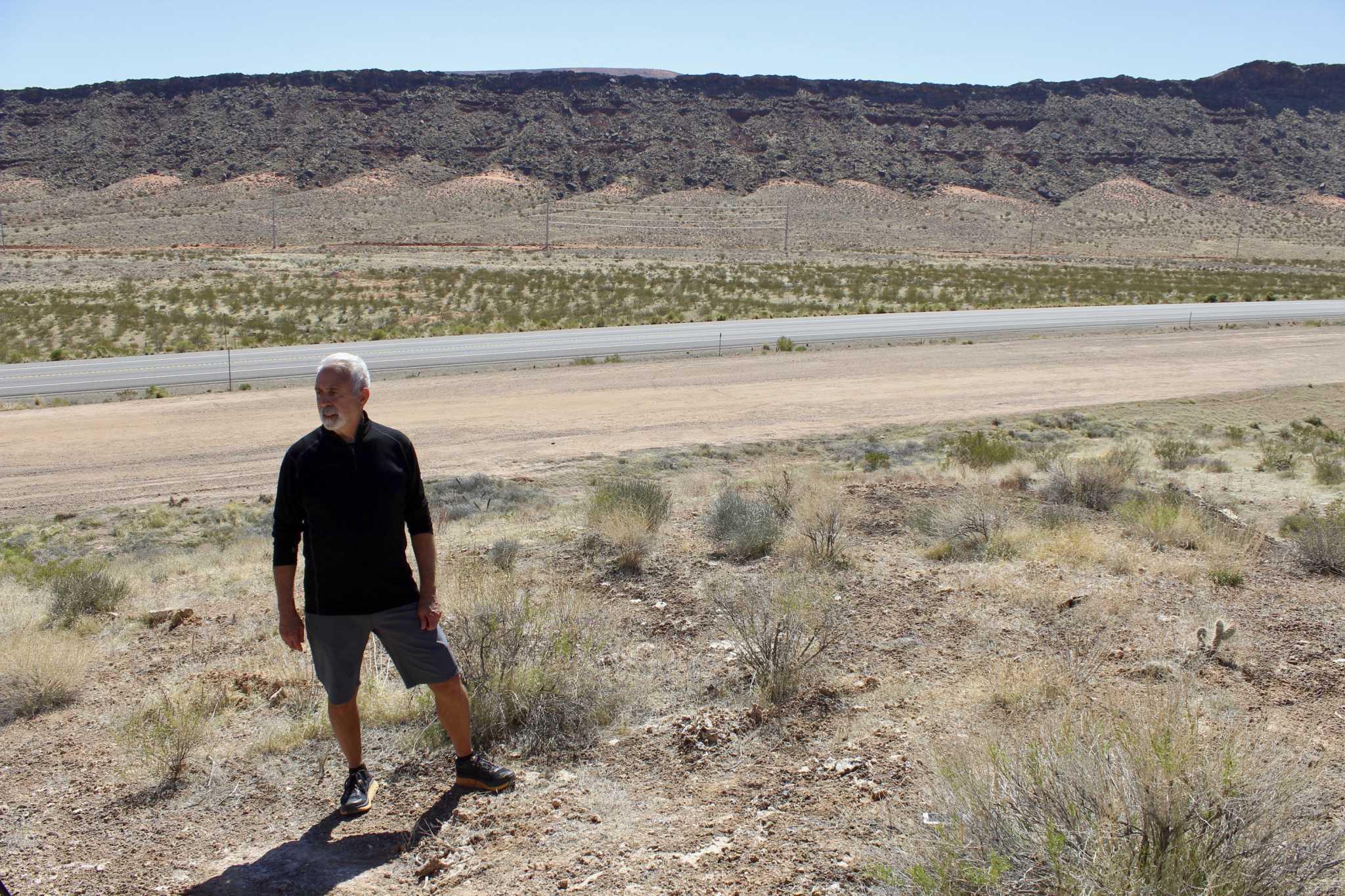Utah
Advocates concerned about Southern Utah road extension
Published
5 years agoon
By Alicia Moore 
Editor

Utah — With construction of the approved Northern Corridor highway through the Red Cliffs National Conservation Area looming, advocates for protected land staying protected are also objecting to another road project set to encroach on sensitive species habitat.
The Long Valley Road extension project aims to connect a planned housing development west of Sand Hollow Reservoir in Washington City to the Southern Parkway by extending the existing Long Valley Road through a corner of what is now the Warner Ridge Fort Pearce Area of Critical Environmental Concern (ACEC).
This 4,000-acre patch of protected land northeast of the airport was set aside in 1999 for the endangered dwarf bear claw poppy, the threatened Siler pincushion cactus, important riparian habitats, historical sites and due to its highly erodible soils, the Spectrum newspaper reported. Conservationists say it is also potential habitat for the threatened Mojave desert tortoise, which already faces encroachment on its once-protected territory by the Northern Corridor highway.
The Bureau of Land Management (BLM) St. George Field Office paved the way for the road to be built with a Nov. 10 Finding of No Significant Impact on the environment, absolving them of the federally-mandated requirement to conduct a full study of the risks in preparation of an Environmental Impact Statement as part of the National Environmental Policy Act of 1969 (NEPA).
But opponents say the BLM failed to consider reasonable alternatives, a step also required by NEPA, that could avoid damage to the ACEC by simply moving the planned interchange north 0.7 of a mile.
“It was obvious there were alternatives that were not analyzed,” said Tom Butine, board president of the local organization Conserve Southwest Utah. “So we suggested one that moved the planned intersection two-thirds of a mile north to avoid the ACEC altogether. The topography is the same. BLM still has jurisdiction in that area. The cost has got to be less since it’s a shorter road. It seems like an obvious alternative.”
Butine submitted this suggestion as a public comment during the environmental review process for the project, asking the BLM to consider this route. The BLM responded by citing the Utah Department of Transportation’s (UDOT) pre-determined locations for potential future interchanges on the same date that it elected to approve the right-of-way application for their original preferred route.
“Currently, UDOT has no plans for the construction of any additional interchanges that would result in a shorter access road being constructed,” the final Environmental Assessment reads. “Consideration of any such interchange would require an application from a qualified proponent who would then plan and pay for the interchange.”
Kevin Kitchen, UDOT Communications Manager for this region, confirmed that specific future interchange locations designated in the 2005 Environmental Impact Statement conducted for the Southern Parkway could have guided current plans for where the Long Valley Road will connect. But he also indicated that considering alternatives would only require authorization from the state transportation agency, something he had not heard of as having been considered.
“When we laid out the Southern Parkway, we designated specific areas where there could be potential future interchanges,” explained Kitchen. “We’d have to sign off on some kind of approval for (a different) connection.”
The Southern Parkway has existing interchanges at mile markers 10 (Warner Valley/Washington Fields) and 15 (Washington Dam/Long Valley). Butine’s proposed route places the new interchange between them at mile marker 13, while the BLM-preferred route crosses the ACEC to connect at mile marker 12.3, near another subdivision on the other side of the parkway.
When asked about whether the alternate route proposed by Conserve Southwest Utah had ever been seriously considered, Christian Venhuizen, spokesperson for the BLM Utah Color Country District, pointed back to Annex E of the Long Valley Road Environmental Assessment, which says that such an action would require “an application from a qualified proponent.” This section also reads that “The BLM evaluated potential reasonable alternatives,” but Butine says he’s never seen any documentation of this, which should be required under NEPA laws.
When asked about how the decision was made to permit a road to cross a protected Area of Critical Environmental Concern, Venhuizen responded that “This decision has been appealed to the Interior Board of Land Appeals, and due to its status, we will not provide further comment on pending litigation.”
That’s because Butine, along with Washington County resident, environmental activist and former BLM employee, Richard Spotts, submitted their questions and objections about the Long Valley Road as a new appeal to the Interior Board of Land Appeals on April 7th, asking for construction to be delayed until reasonable alternatives could be adequately considered.
But they’re not at all sure it’s going to work.
“A lot of people have told us that it’s a real long shot to get this board to grant stays,” Spotts said. “And sometimes this board doesn’t act in a very timely way. The tortoises could be removed and some of the roadwork could occur even before we get a decision. And after they’ve removed the tortoises and bladed the road and buried the seed bank for the dwarf bear claw poppy, it’s kind of a moot point beyond that, even if we win on paper.”
The November document granting the project its right of way outlines a construction schedule starting with grading and utility installation under the road in the spring of 2021. Butine said he worries that the local BLM operates under a policy of “ask forgiveness rather than permission,” and that by the time the court rules on their appeal, the damage to the ACEC and its sensitive species would already be done.
“Since we suspect the bulldozers are going to be out within a month, we were worried about whether, if we submit a stay right now, is the court going to be able to get to it in time to stop action,” Butine said. “The preliminary word on that is that the court has become so understaffed and backlogged with a record number of appeals during the Trump administration that they’re now trying to determine if there’s any way they could get to our petition for a stay. It’s starting to look a little bleak for actually getting them to stop.”
Butine and Spotts’ appeal leans heavily on protections for the Mojave desert tortoise, citing risks to that species 78 times in their 30-page statement of reasons even though the Warner Ridge Fort Pearce ACEC was designated specifically for the protection of the dwarf bear claw poppy and the Siler pincushion cactus. But they say the bigger issue is a troubling pattern of behavior by local government agencies of ignoring federal mandates to protect land and species in favor of constant development.
“It’s clearly tiny compared to the Northern Corridor in terms of impacts. But the similarities are that the BLM basically abdicated any independent authority or analysis,” Spotts said. “Because UDOT says we want to put a future interchange at this specific place on the Southern Parkway and Washington City decides this road needs to go through habitat that was established with the Dixie Resource Management Plan in 1999, we just do that? Once BLM designates ACECs, they should stand up for them.”
There is a precedent for BLM engaging in seemingly contradictory actions in regards to protecting this ACEC under their management. In March 2016, the local BLM office renewed a ten-year permit allowing livestock grazing within the Warner Ridge Fort Pearce ACEC despite acknowledging that the area had been protected due to two federally-listed, delicate plant species and “highly erodible soils.” As a mitigating solution, they proposed “establishing long-term study plots to monitor the general health of individual plants and any noticeable effects of grazing activities.”
Butine says the fate of the tortoises now lies with Washington City, which he fears “is unwilling to wait for the appeal process.” Meanwhile, Washington City Public Works Director Mike Shaw told The Spectrum & Daily News that his office “does not have a Long Valley Road extension project.” Progress on building the road, he says, is entirely up to the subdivision developer, listed on the right-of-way decision record as Brennan Holdings, LLC.
Furthermore, Shaw said, “there are no tortoise out there that I’m aware of and it’s not even really good poppy habitat because they’re usually on gypsum soils.” He also expressed confidence in the federal process, stating that “If (the project) was actually in the area of concern, the BLM would never have issued a permit for it.”
The BLM’s own documents acknowledge that the road will cross the ACEC, but they argue that the project is an overall win for the desert tortoise because it is the result of a land exchange that allowed Washington County to acquire a private parcel of land within the Red Cliffs National Conservation Area, prime tortoise habitat, by trading these formerly-BLM-controlled lands off of the Southern Parkway.
“The Red Cliffs/Long Valley Land Exchange decision in October 2016 allowed the BLM to acquire more than 83 acres of privately-held lands in the Red Cliffs Desert Reserve for the protection and recovery of the threatened Mojave desert tortoise,” Venhuizen said.
There are no clear answers yet as to whether or when the Long Valley Road extension project will proceed. Bulldozers sit idly at the entrance to Holdings’ planned 2,000-unit subdivision. Meanwhile, road grading for the widening of the Southern Parkway — which already cuts through a corner of the ACEC — is underway to accommodate increased traffic along this road as housing subdivisions fill in on either side.
“Our spectacular outdoor environment is the driver of our growth in population, tourism and economy,” Butine said. “Yet this growth is being managed in a way that is destroying our scenic and sensitive landscapes, the very reason people value this area, bit by bit.”




